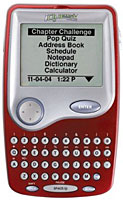iQuest Handheld from Leapfrog
Feedsee Toys : iQuest Handheld from Leapfrog : Study at maximum velocity
 This interactive talking handheld makes studying for tests fast, fun and effective with interactive audio quiz games and printable chapter outlines based on your school textbooks. Customize your quizzes by visiting the LeapFrog Web site and downloading correlated questions and chapter outlines. Plus, it's a personal organizer complete with dictionary, address book, calendar, and calculator. Designed to act as a portable, personal study tool, the iQuest 4.0 PDA handheld makes studying more fun and engaging.
This interactive talking handheld makes studying for tests fast, fun and effective with interactive audio quiz games and printable chapter outlines based on your school textbooks. Customize your quizzes by visiting the LeapFrog Web site and downloading correlated questions and chapter outlines. Plus, it's a personal organizer complete with dictionary, address book, calendar, and calculator. Designed to act as a portable, personal study tool, the iQuest 4.0 PDA handheld makes studying more fun and engaging.
Evolution of PDAs for Learning and Educational Applications
Personal Digital Assistants (PDAs) have undergone significant transformations since their inception, especially in the realm of learning and education. Here's a look at their evolutionary journey:
- Early Beginnings: PDAs initially emerged as digital organizers in the 1980s and 1990s, primarily used for basic tasks like calendar management, note-taking, and address book functionalities.
- Integration of Educational Software: As PDAs became more sophisticated, educational software developers began creating applications tailored for these devices. These included digital textbooks, flashcard apps, and basic language learning tools.
- Connectivity and Collaboration: With the advent of wireless technologies, PDAs started supporting internet connectivity. This allowed students and educators to access online resources, collaborate in real-time, and participate in virtual classrooms.
- Enhanced Multimedia Capabilities: PDAs evolved to support audio and video, enabling multimedia educational content. This made learning more interactive and engaging, with video lectures, podcasts, and interactive simulations.
- Stylus and Handwriting Recognition: Many PDAs came with a stylus, allowing users to take handwritten notes. Some advanced devices even had handwriting recognition, converting handwritten notes into digital text, which was particularly useful for quick note-taking during lectures or meetings.
- Transition to Smartphones and Tablets: As technology advanced, the distinction between PDAs, smartphones, and tablets blurred. Modern smartphones and tablets inherited many PDA features, but with vastly improved processing power, storage, and display capabilities. Educational apps became more sophisticated, offering a broader range of functionalities and learning modalities.
- App Ecosystems: The rise of app stores transformed the educational potential of PDAs and their successors. Thousands of educational apps covering various subjects and catering to different learning styles became available, making personalized learning more accessible.
- Augmented Reality (AR) and Virtual Reality (VR): Modern devices, which are the evolutionary successors of PDAs, now support AR and VR functionalities. These technologies offer immersive learning experiences, from virtual field trips to interactive 3D models for subjects like anatomy or engineering.
PDAs paved the way for the mobile learning revolution. Their evolution from simple digital organizers to powerful learning tools showcases the potential of technology to transform education, making it more accessible, interactive, and tailored to individual needs.